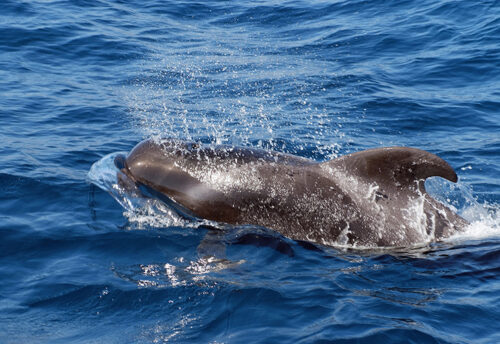
The Caspian seal, 1 of the smallest members of the earless seal family, is rare in that it is found among the brackish (partially salty) Caspian Sea. These seals prefer to dwell along the shorelines, however, they also can be found on the numerous rocky islands and floating blocks of ice that are scattered throughout the Caspian Sea. They face many threats to their survival including the threats of habitat loss and destruction at the hands of residential and commercial developments, oil and gas drilling, various ecosystem modifications; habitat division at the hands of shipping lanes, which can result in vehicle strike (being hit by vehicles); overfishing; recreational activities, that can interrupt their breeding grounds; invasive species; pollution; and climate change, that can cause premature ice melt and increased water & air temperatures as well as harbor diseases that often die off in longer, colder winters. The IUCN lists these critters as Endangered, and their population trend is unknown.
First the Stats…
Scientific name: Pusa caspica
Weight: Up to 190 lbs.
Length: Up to 4.25 feet
Lifespan: Up to 50 years
Now on to the Facts!
1.) There are only approximately 168,000 of these seals remaining, to date, from over 1,500,000 at the start of the 20th century.
2.) They are also found in the deltas of the Volga and Ural Rivers, as well as the southern latitudes of the Caspian Sea, where the water is a bit cooler due to its greater depth.
3.) Scientific evidence suggests that the colonization events of Caspian seals probably began due to river connections from the Arctic that have since disappeared, landlocking the populations sometime before the major Pleistocene glaciations.
4.) Their skull structure suggests they are closely related to the Baikal seal. Also, the morphological structures in both species suggest they are descended from the ringed seal which migrated from larger bodies of water around 2,000,000 years ago.
5.) Temperatures in the Caspian Sea are broad and can range from -31ºF in the winter months to 104ºF in the summer!
But wait, there’s more on the Caspian seal!
6.) In the eastern part of the Caspian, the most crowded place used to be Ogurchinskiy Island, but by 2001, fewer than 10 pups were located on Ogurchinsky, some of which were sadly killed by the people on the island.
7.) Caspian seals prey on crustaceans and various fish.
Did you know…?
These seals can eat up to 7 lbs. of food a day and up to 1 metric ton of fish per year.
8.) Being 1 of the top predators in the ecosystem, Caspian seals have been found to have hazardous chemicals found inside their bodies like heavy metals, organochlorine compounds, and radionuclides.
9.) They are shallow divers that swim to depths of up to 160 feet for up to 1+ minute at a time. However, deeper and longer dives have been recorded.
10.) During summer and winter they dwell in large groups. The rest of the year they are more solitary.
But wait, there’s still more on the Caspian seal!
11.) With what little is known of their general behavior, it has been documented that aggressive snorts and flipper waving are both used to warn others to stay clear.
12.) These seals are monogamous (mate for life).
Did you know…?
These seals utilize a capital breeding lactation strategy, wherein the mother will fast while nursing her pup, sometimes with a small amount of supplemental feeding, here and there.
13.) Females undergo up to an 11 month gestation (pregnancy) that yields a single pup.
14.) In the past, successful pregnancy rates were as high as 70%. However, recent studies have found that number to be a low 30%!
15.) Pups are born with white pelages (fur that covers their skin) and weigh in at up to 11 lbs.
But wait, there’s still a bit more on the Caspian seal!
16.) Weaning is complete in just a few week’s time and the pup’s white coat is molted in 3 – 4 weeks.
17.) Breeding typically happens again after weaning of a newborn pup, but can sometimes begin while the pup is still nursing.
Did you know…?
Numerous recent cases of large numbers of Caspian seals dying due to canine distemper virus have been reported, in 1997, 2000, & 2001; resulting in upwards of 10,000 seals perishing along the Kazakhstan coast.
18.) In a 3-week period in February 1978, wolves were deemed responsible for the killing of numerous seals near Astrakhan. An estimated 17 – 40% of the seals in the area were killed, however not eaten.
19.) Steller’s sea eagles are known to hunt juveniles. Wolves hunt both juveniles and adults. These seals are also hunted by humans for commerce and subsistence.
20.) The seal habitat in Kenderli Bay is currently threatened by an impending large-scale coastal resort development. This resort development has the potential to be a serious disturbance for seals. The local authorities have been advised about the need to preserve the seal habitats in the bay, however it is not yet clear what steps are planned to achieve this.
Now a Short Caspian Seal Video!
Be sure to share & comment below! Also, check out the Critter Science YouTube channel. Videos added regularly!
Want to suggest a critter for me to write about? Let me know here.
Some source material acquired from: Wikipedia & IUCN
Photo credit: Mehr News Agency




